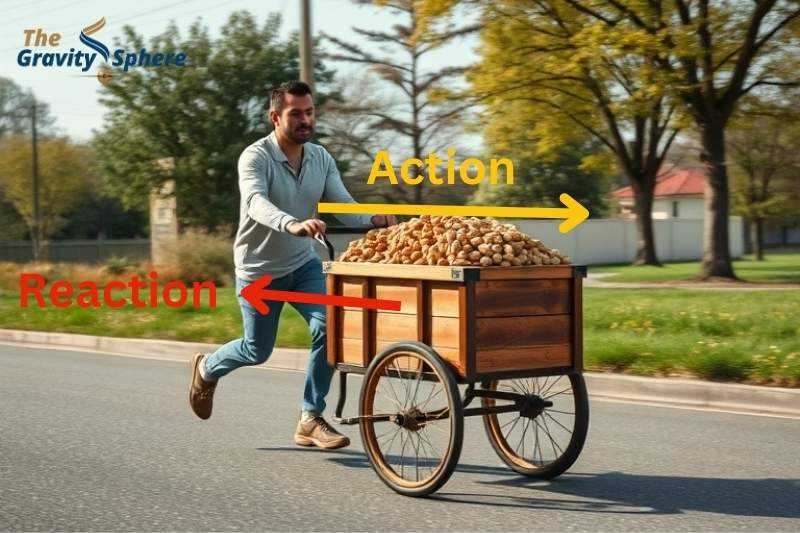If you push the tip of a ballpoint pen against your thumb, you will feel a dent form on your thumb’s surface. The harder you press, the deeper the dent becomes. This simple action demonstrates that forces always interact between two objects: when your thumb pushes on the pen, the pen pushes back on your thumb with an equal force in the opposite direction. This is in accordance with Newton’s Third Law of Motion:
“For every action, there is an equal and opposite reaction.”
Let’s dive into this fundamental concept and explore what it means in simple terms.
What Is the Purpose of Newton’s Third Law?
Newton’s Third Law helps us understand how forces work between objects. It shows that forces always act in pairs. When one object applies a force (action), the other applies an equal force in the opposite direction (reaction) in its response.
Why the Objects Move If Forces Are Equal and Opposite?
At first, it seems confusing. If the action and reaction forces are equal and opposite, shouldn’t they cancel each other out? But here’s the catch: the forces act on different objects!
Take the example of a person pushing a peanut cart on a road. The person applies a force (F₁) on the cart; this is the action force acting on the cart. The cart, in turn, applies an equal and opposite force (F₂) on the person; this is the reaction force. Both forces act for the same length of time.
It is important to note that the action force acts on the cart, while the reaction force acts on the person. These forces act on two different bodies (the cart and the person), but never act on the same body.
For the cart to move, it needs to be subjected to an unbalanced force. The action (F₁) on the cart is unopposed in the direction of the push, which causes the cart to accelerate. The reaction (F₂) acts on the person and is felt as the effort needed to push the cart forward.
Therefore, the cart moves because it is under the influence of the unbalanced action force, whereas the reaction force only affects the person pushing the cart.
Can Action and Reaction Forces Cancel Each Other?
No, the action and reaction forces cannot cancel each other. As they are equal in magnitude and opposite in direction, they act on different objects. For example, when a person pushes a cart, the person applies a force (F₁) on the cart (action), and the cart applies an equal and opposite force (F₂) on the person (reaction). Since these forces act on different objects—the peanut cart and the person—they don’t cancel each other out.
For the cart to move, the action force (F₁) is the only force that is acting on it in the direction of the push. The reaction force (F₂) acts on the person, not the cart. Therefore, the forces don’t cancel each other; instead, they cause movement
The Horse and Cart Example: Action and Reaction on the Road
A horse pulling a cart is a great example of Newton’s Third Law in action. The common and very interesting question is:
“Is the action on the cart, the road, or both (cart and road)?“
In this case, the action is the force the horse applies to the cart by pulling it forward, and the reaction is the force the cart applies back on the horse, pushing it backward. While the ground does provide friction, which helps the horse move, the direct action and reaction forces happen between the horse and the cart. So, the action is on the cart only.
Why “both cart and ground” is not the answer?
The answer is not both the cart and the road because action and reaction forces act on different objects. In the case of a horse pulling a cart, the action force is the horse pulling the cart, and the reaction force is the cart pulling back on the horse. The road only provides friction, which helps the horse move, but it doesn’t create a reaction force on the cart. So, the action and reaction forces happen between the horse and the cart, not between the cart and the road.
Everyday Examples of Newton’s Third Law
This law is everywhere around us! Here are a few examples:
- Swimming: You push the water backward with your arms (action), and the water pushes you forward (reaction).
- Rocket Launch: The rocket expels gases downward (action), and the rocket moves upward (reaction).
- Jumping: When you push down on the ground with your legs (action), the ground pushes you upward (reaction).
- Bouncing a Ball: When you throw a ball on the ground (action), the ball pushes down, and the ground pushes the ball back up (reaction).
- A Book Lying on a Table: When a book is lying on a table, it pushes the table downward (action), and the table pushes the book upward (reaction).
Newton’s third law vs law of conservation of momentum
Both Newton’s Third Law and the law of conservation of momentum work together to explain motion. Newton’s Third Law states that for every action, there is an equal and opposite reaction. This means when one body applies a force on another, the second body pushes back with the same force in the opposite direction. Since these forces act on different objects, so, they do not cancel each other.
The law of conservation of momentum states that the total momentum of a system remains constant unless an unbalanced external force acts on it. When two objects interact, such as by pushing or pulling each other, the momentum one object loses is exactly gained by the other.
In simple terms, Newton’s Third Law describes how forces act between objects, while the law of conservation of momentum ensures that the total momentum in the system stays balanced, with no momentum lost overall.


Leave a Reply